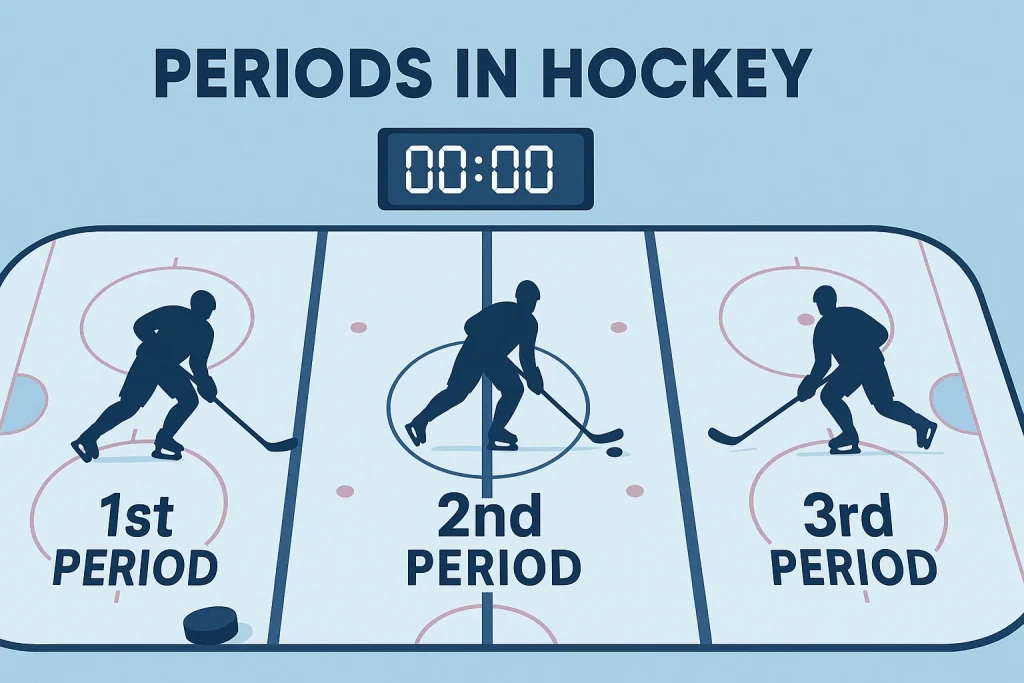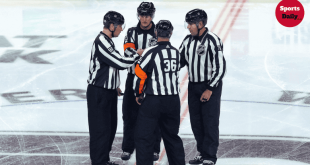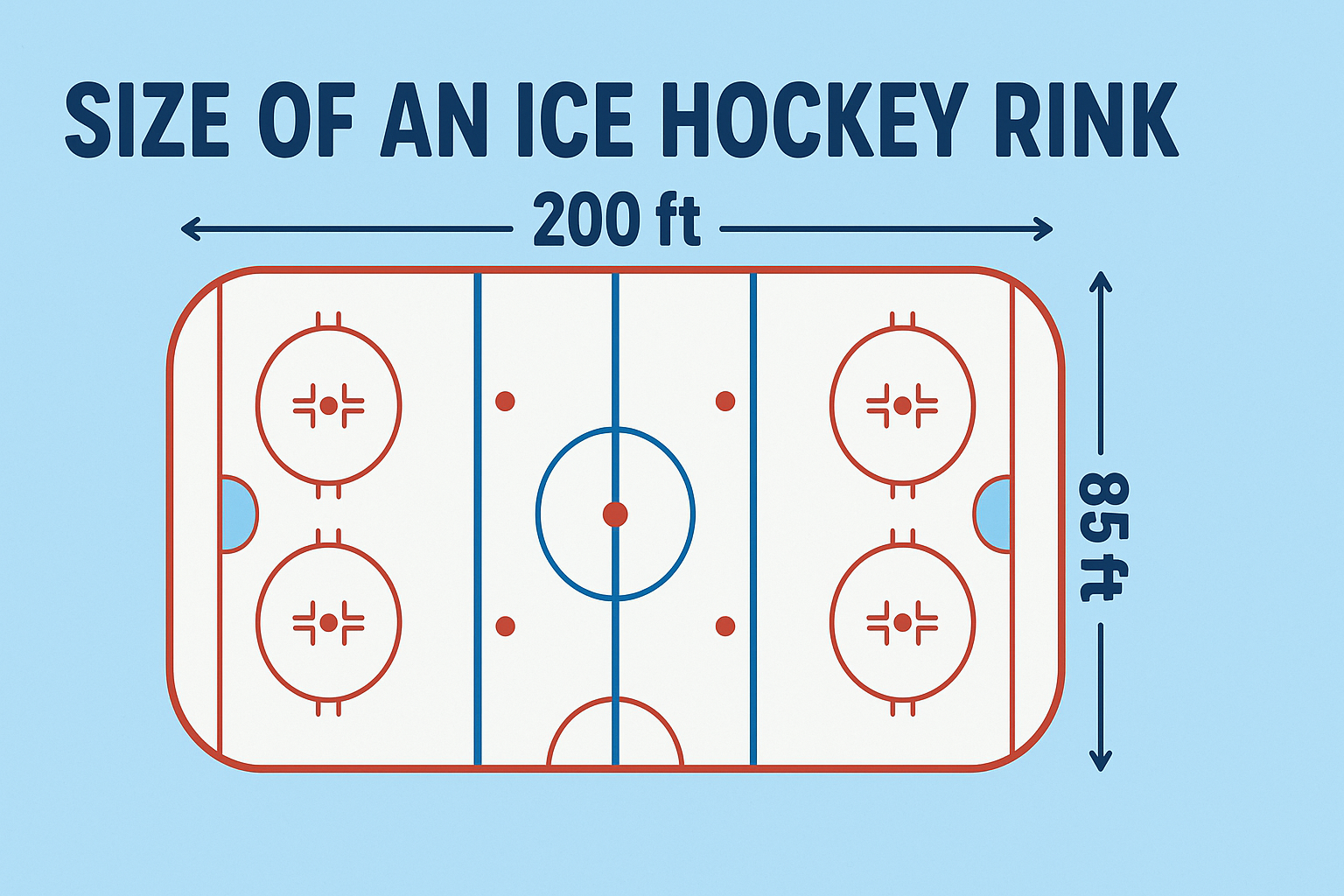Having spent years analyzing games from the sidelines and working closely with broadcast crews, I’ve come to appreciate just how intricate and thrilling hockey really is. From the slap shots to sudden-death goals, every second counts. But one question I often hear from new fans is surprisingly simple: How many periods are there in a hockey game?

If you’ve ever found yourself asking the same thing while watching the NHL or a local junior league, you’re not alone. Hockey’s structure isn’t quite like football’s four quarters or soccer’s two halves. It has its own unique rhythm—one that makes the game even more strategic and fast-paced.
In this article, I’ll break down everything you need to know about periods in hockey. Whether you’re new to the sport, a casual viewer, or even helping your kids learn the game, understanding how hockey is timed will help you follow the action more clearly and enjoy it even more.
Comparison of Game Structure: Hockey vs. Football, Basketball, and Soccer
| Sport | Game Duration | Periods/Quarters/Halves | Breaks | Overtime Rules |
| Hockey (NHL) | 60 minutes | 3 periods (20 min each) | 2 intermissions (17-18 min each) | 5-min OT + shootout (regular season), 20-min sudden death (playoffs) (source) |
| Football (NFL) | 60 minutes | 4 quarters (15 min each) | 1 halftime (12-15 min), short breaks between quarters | 10-min OT; sudden death if first team scores TD (source) |
| Basketball (NBA) | 48 minutes | 4 quarters (12 min each) | 1 halftime (15 min), short breaks between quarters | 5-min OT; repeated until winner (source) |
| Soccer (FIFA) | 90 minutes | 2 halves (45 min each) | 1 halftime (15 min) | 30-min extra time (2 halves), then penalty shootout if needed (source) |
Contents
Standard Period Structure in Hockey

Hockey is played in three periods, not four quarters like in basketball or two halves like in soccer. This format sets the sport apart and keeps the pace fast and exciting.
Each period in professional hockey—like the NHL—is 20 minutes long. The clock runs only when the puck is in play. That means every time there’s a whistle, like for a penalty or icing, the clock stops. This makes the actual game longer than 60 minutes.
At the end of each period, teams switch ends. This helps balance out any rink advantages, like ice tilt or lighting. It’s also why stamina and strategy are key in the third period—players are often exhausted by then, and a single mistake can change the game.
Game Structure by Hockey League: Periods, Intermissions, and Overtime Rules
| League | Periods | Intermission Time | Overtime (Regular Season) | Overtime (Playoffs) |
| NHL | 3 x 20 minutes | 17-18 minutes | 5-minute 3-on-3 OT + shootout | 20-minute sudden death, repeat until goal (source) |
| AHL | 3 x 20 minutes | 17 minutes | 7-minute 3-on-3 OT + shootout (source) | Same as NHL |
| NCAA (College Hockey) | 3 x 20 minutes | 15 minutes | 5-minute 5-on-5 OT, varies by conference (source) | 20-minute sudden death |
| Junior (e.g., CHL) | 3 x 20 minutes | 15-17 minutes | 5-minute 3-on-3 OT + shootout (source) | 20-minute sudden death, multiple OTs if needed |
In leagues like the American Hockey League (AHL) or college hockey, the rules are almost the same. But in youth hockey, periods might be shorter—often 12 or 15 minutes—to match skill levels and keep the kids energized.
Understanding the regulation time in hockey—those three 20-minute periods—gives you the base. But what happens between them? That’s up next.
What Happens Between Periods?
After each period, there’s a break called an intermission. It usually lasts 15 to 18 minutes, depending on the league and the event.
During this time, a few key things happen:
- The ice is resurfaced with a Zamboni to keep the surface smooth and safe.
- Players head to the locker rooms to rest, hydrate, and talk strategy with coaches.
- Fans can grab snacks, hit the restroom, or enjoy entertainment in the arena.
In the NHL, intermissions often include commentary and replays on broadcasts. If you’ve ever watched a game on ESPN or Sportsnet, you’ve seen the break filled with expert analysis and highlights.
These breaks also give coaches a chance to adjust tactics. I’ve seen teams come out after the second intermission with completely different energy, especially when they’re trailing and need a late-game push.
Understanding the purpose of intermissions makes the flow of the game easier to follow. And once the third period wraps up, you might get to see the most thrilling part—overtime.

Overtime Rules in Hockey
When the game is tied after three periods, it goes into overtime. This is where the tension kicks up a notch.
In the NHL regular season, overtime is a single 5-minute period, but here’s the twist: teams play 3-on-3, not the usual 5-on-5. That gives players more space to move, which often leads to fast-paced, sudden-death goals. The first team to score wins. If no one scores, it goes to a shootout—a one-on-one battle between a shooter and goalie.
For full details, you can check the NHL overtime and shootout rules here.
In the playoffs, though, it’s a different story. No shootouts. Just pure hockey. Overtime consists of full 20-minute periods with standard 5-on-5 play. Teams keep going until someone scores. I’ve covered games that went into double or triple overtime—it’s intense, emotional, and unforgettable.
Other leagues like IIHF and college hockey have their own variations too. Some use shorter OTs, others skip the shootout altogether.
Overtime Rules in Different Hockey Leagues: Regular Season vs. Playoffs
| League | Regular Season Overtime | Playoff Overtime |
| NHL | 5-minute 3-on-3 OT, then shootout if tied (source) | 20-minute sudden-death OT, full periods until a goal is scored (source) |
| NCAA (College) | 5-minute 5-on-5 OT, some conferences use shootout | 20-minute sudden-death OT, multiple periods if needed (source) |
| IIHF (International) | 5-minute 3-on-3 OT, then shootout | 10 or 20-minute OT depending on the round, then shootout (except for gold medal games – continuous OT) (source) |
| Youth/Amateur Leagues | Varies: 3–5 minute OT or direct to shootout | Often not used; games can end in ties or use short OT |
This sudden-death format adds a layer of drama you won’t find in many other sports. And it’s one reason fans keep coming back for more.
Variations Across Hockey Levels
While professional leagues like the NHL use three 20-minute periods, the rules can vary depending on the level of play.
Let’s start with youth hockey. Most youth leagues use shorter periods—often 12 to 15 minutes. That’s because kids are still learning the game and don’t have the same stamina as adults. It also helps keep the pace fun and safe. Some youth tournaments even use running clocks to speed things up.
In college hockey, especially in the U.S., the structure is closer to the NHL. Games still have three periods, each lasting 20 minutes. But NCAA rules sometimes differ when it comes to overtime and penalties. For example, some conferences use 5-minute overtime followed by a shootout, while others allow ties in the regular season.
International hockey—like the IIHF World Championships or the Olympics—also follows the three-period format. However, the rules around overtime, player rosters, and even rink size can be a little different. International rinks are often wider, giving players more room to skate and pass.
In junior hockey—leagues like the CHL in Canada or USHL in the States—the period structure is the same. But since the players are teens, coaches often adjust strategies to suit their development level.
No matter what level you watch, the three-period format stays pretty consistent. But the way those periods are played can shift based on age, skill, and league rules.
Why 3 Periods Instead of 4 Quarters?
This is a question I’ve heard a lot—especially from fans used to sports like football or basketball. So why does hockey use three periods instead of four quarters?
The answer goes back to the early days of the sport. Back then, ice quality was a big issue. By breaking the game into three periods, there were more chances to resurface the ice and keep things fair. A fresh sheet of ice helps the puck glide better and reduces injuries. That’s still true today.
Another reason? Strategy. Three periods break the game into more distinct chunks. Coaches can plan better, make adjustments, and manage player fatigue. It also gives fans a good flow—two intermissions instead of one long halftime keeps the action moving without long breaks.
Plus, hockey is a game of speed and momentum. Four quarters might disrupt the rhythm. With three periods, teams get enough rest and reset without killing the tempo.
If you’re curious, the official format has been backed by decades of play and tradition across all top leagues. You can even see it in the official NHL rulebook.
So while it may seem odd at first, the three-period system actually helps keep the game smooth, fair, and thrilling from start to finish.
Common Questions Around Hockey Periods
Let’s clear up some quick questions I often get from fans during broadcasts and events:
How long is each period in hockey?
In most pro and college games, each period is 20 minutes long of stop-time play. Youth and amateur levels may have shorter periods.
How long is a full hockey game including intermissions?
With three 20-minute periods and two 15–18 minute intermissions, a typical game lasts about 2 to 2.5 hours in real time. TV timeouts and stoppages can extend that a bit.
What happens if a game is tied after three periods?
In the regular season, most leagues play a short overtime. If still tied, they go to a shootout. In playoffs, it’s full sudden-death overtime until someone scores.
Are periods different in women’s or youth hockey?
Yes. Many women’s and youth games have shorter periods to match the skill and energy level of players. The structure is usually the same—just adjusted for time.
Does the clock stop during play?
Yes, in professional and most organized hockey, the clock stops for every whistle. This keeps things fair and ensures full use of the timed periods.
Want more official info? The USA Hockey rulebook offers a great breakdown for youth and amateur levels.
Summary & Final Thoughts
Having followed hockey closely for years—from NHL arenas to youth tournaments—I can tell you this: understanding periods in hockey is one of the best ways to enjoy the game more deeply.
Whether you’re watching a fast-paced NHL showdown, a tense Olympic final, or a weekend youth match, the three-period format stays consistent. It sets the rhythm of the game, shapes the strategy, and creates that signature hockey flow we all love.
From regulation time to overtime rules, and from youth league tweaks to international differences, each period builds on the next. It’s not just about watching a puck move—it’s about following momentum shifts, reading line changes, and feeling the energy rise as the clock winds down.
If you’re just getting into hockey, keep this in mind:
- Each game has three periods.
- Each period is 20 minutes long.
- There are breaks (intermissions) between them.
- If tied, there’s overtime—and maybe a shootout.
And if you’re a die-hard fan already, these insights might help you explain the game better to new friends—or even win a trivia night.
📊 [Insert table summarizing key period rules by league – NHL, NCAA, IIHF, Youth]
I’ve seen first-timers fall in love with hockey after just one game. And it often starts by simply understanding the structure of play. Once that clicks, everything else—goals, penalties, saves—makes more sense.
FAQ Section
Here are quick answers to some of the most common questions about hockey periods:
Q: How many periods are in a hockey game?
A: Three periods. Each one is 20 minutes long, making up 60 minutes of regulation time. Learn more here.
Q: How long are the intermissions?
A: Usually 15 to 18 minutes. That gives time for ice resurfacing and player rest. Some youth leagues may have shorter breaks.
Q: Why doesn’t hockey use quarters like other sports?
A: It’s all about tradition and keeping the ice in good shape. Here’s a deeper look.
Q: Can a hockey game end in a tie?
A: In the NHL, no. If it’s tied after three periods, there’s 3-on-3 overtime, then a shootout. But in some youth or college leagues, ties are allowed. Check NCAA rules here.
Q: What is sudden-death overtime?
A: It means the first team to score wins. In NHL playoffs, overtime periods are full 20-minute rounds—no shootouts.
Q: Is the ice size the same in every league?
A: Not quite. International rinks (like in the Olympics or IIHF) are wider than NHL rinks. That affects how periods play out. Learn about rink sizes.
 Sports Daily Info All Things Sports, from News to Match Schedules
Sports Daily Info All Things Sports, from News to Match Schedules



